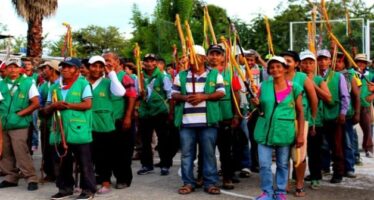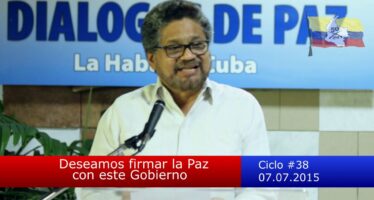From the long war to the new party

![]()
Three months after joining the FARC, we were concentrated in the La Reserve camp, a cold, wooded area above Ciénaga, in the Sierra Nevada of Santa Marta.
There I was able to deal directly with the commander of the Front, Adán Izquierdo, and an Assistant of the Central Staff sent by the Secretariat, Oscar Narváez. I also met other well-known members who had joined after me.
One of them was Ricardo Palmera who, only months later, decided to call himself Simon Trinidad. We were good friends in the city, and I think that from that moment we became even closer. Maybe we would be about twenty students.
We had the peculiarity of being ideological and political instructors in the morning, and to assume the role of students the rest of the time, dedicated to the military preparation. In that place I developed my first affections with the guerrilla world.
There was a big black man, Domingo Biojo, with whom I built a great friendship. He was a direct descendant of a leader of the banana strike of 1928. Julián Conrado, with two or three years in the ranks, was the professor of philosophy and he also sang his own songs during the cultural hours. At that time he was not playing the guitar. And there was a Samario boy, Sánchez, histrionic, smiling and dreamy, with whom I developed a confidence close to brotherhood.
They were, along with Alberto and a few others, the political cadres.
The others were peasants, girls and boys with excellent humor, from whom I learned the real meaning of fraternity. Physically, they excelled in everything, with surprising ease. They were the most adeguate for the environment in which we were. But they taught and helped laughers to those who struggled to learn and do practical things.
In remembering those times my mind digs desperately in search of the names of the survivors. The fate of Simon we know. I think that with the exception of Julian and Jairo Quintero, who was our brave military instructor, nobody else who was in my basic course is alive. And there are only three or four guerrillas or commanders from that time who could tell the story. Even the most important leaders died years later.
War devours little by little. Some because they left, deserters, renegades, traitors. Others because they were killed in combat or killed while fulfilling a mission. Now that I think about it, the constant in guerrilla life has always been that. An imminent danger of dying or being put in prison if you were lucky. If it were not for the permanent renewal capacity of the guerrillas, it would have been annihilated many times.
Always and everywhere there were new faces. People who joined our ranks, women and men of the city or town, who for one reason and another also went to the mountain as I had. I spent five years in the Sierra Nevada and then eight in the Magdalena Medio, south of Bolivar and the Northeast of Antioquia. That is why I feel so close to the current strike of the miners of Segovia and Remedios. Later I would live the Caguán experience during the peace talks.
I spent more than ten years between the FARC’s South and East Blocks, in very intense phases of the confrontation, before living another four years in the Catatumbo region. The peace process with Santos would eventually take me to Havana. Here and there I saw happy faces of guerrillas busy with their tasks. A large number of them took the war, maybe they will be anonymous soldiers of the revolution forever.
Every survivor must remember many.
A lot of people outside were also killed. They exterminated the Union Patriotica and other political and social movements. The symbiosis between drug trafficking and traditional ruling classes reached prominent figures of the latter, such as Luis Carlos Galán and Álvaro Gómez Hurtado. Paramilitarism enjoyed all state liberties, to bathe the country in blood and facilitate the appropriation of land by businessmen, landowners and even foreign companies.
A high percentage of the deaths in the guerrilla ranks remained silent. If the troops did not take their bodies to bury them in mass graves, the guerrillas themselves buried them in lost graves in the middle of the jungle. One day I proposed that we attempt an estimate of the number of fighters who had perished, which could be extended to the number of Colombians who had once been members of the FARC. How many were the guerrillas, how many died?
Such figures are impossible to pin down. We have more than eighty fronts operating throughout the country, at least with a hundred members. At the same time that some were killed by enemy bullets, others were joining the organization. And it cannot be said that the deaths reached only the base personnel or middle managers. Many commanders also perished. Companies, Columns, Fronts and Blocks were adopting their names.
There were never so many units to baptize with all the names of the dead. Not counting those who left because of diseases, accidents, suicides. Those killed by traitors, those who had to be shot after the war trials. There were also many who ended up in jail and after spending time in it never came back to the ranks. Half a century long guerrilla struggle was not only victories, we also suffered serious and painful failures. Which leaves an idea, what survives as such is the organization, or, to put it another way, the organized struggle of those at grassroots.
What counts, and the only thing that will count, is the work, as Fidel Castro would say, not the names of those who achieved it. Among other things, because it is completely unfair to attribute to a single individual, or a select group of them, what is in fact the product of the joint effort of thousands of human beings.
Those who achieved the signing of the Havana Final Agreement were not the members of the peace delegation and their advisers. It was all this group of guerrillas who endured for so many years the inclemency of war, those who died raising the flag of the fight, those who paid in prison many years without giving up the cause. They all embody the rebellious spirit of the people that led them to the ranks of the revolution.
And that is why the Final Agreement is sacred. Because it gathers and synthesizes the incessant effort of an indeterminable number of combatants of both sexes, of the most diverse origins and with the most dissimilar life stories. It belongs to a people that fought for decades sacrificing everything, and that has managed to take from the oligarchy of their country, the solemn commitment to outlaw violence, as a resource to respond to their social and political cries.
It is not anything that was conquered with that Final Agreement. The ruling classes of our country have sworn before the country and the international community that there will be all sorts of guarantees for the social and political struggle that will eliminate the cancer of paramilitarism and crime, that they will do everything in their power to ensure that no one perishes in our country because of his political ideas. And even more, they signed the creation of the material mechanisms to make it possible.
It is evident then that the next step of those who achieved such a commitment, is to work consciously and organized to have it fulfilled.
The door that we have opened to the political and social struggle in Colombia is waiting for a people mobilized by the exercise of their rights. And it is we, because of our condition of revolutionary professionals, that we have the duty to orient and direct it toward that goal. The oligarchy is not going to do it.
Bad service is given to this cause who proclaim to the four winds that the Havana Agreements are a small thing, that is impossible that they can be applied. Just now, when we require more faith in our work, to study it thoroughly to understand its exact meaning, and to mobilize the whole of Colombia with them, any attack on what is approved at the Negotiation Table, in our Conference and in our Plenaries must be rejected.
It is simply the historical struggle of a people that moves forward.
This struggle is a class struggle, against the almost all-powerful power of capital, against all its weapons and tricks. So it will not be easy. We put aside the rifles because now we have a very powerful weapon if we know how to value the Final Agreement. We have trapped, from its weakest part, the Colombian oligarchy, it is now when we need to tighten and know how to do it.
The ruling class will comply if we force it to do so. And to force it we have to launch a people over it. A people who has learned from so many years of violence and death, who do not want to hear the voices calling it back to war. That longs for a different discourse, which will follow those who know how to elaborate it, those who speak of effective peace and justice, who prove in reality to be different, have a total transparency and unquestionable.
Let us invite a people to life and joy. That is the purpose we will pursue with the new party. Death and terror belong to our adversaries.
Whenever their hands are stained with blood, whenever they violate and oppress, the repudiation against them must be general.
We have to isolate them, expose their criminal and corrupt condition before the eyes of all. And at the same time we should show ourselves as the option for our country, the option of peaceful coexistence and decency.
That is the task awaiting us.
Related Articles
Acuerdos entre Cumbre Agraria y gobierno de Colombia
![]()
Entrevista con Jimmy Moreno, alcances de los acuerdos logrados
Guerrillas are optimistic and think of the post-conflict
![]()
Tanja Nijmeijer is known as “the Dutch guerrilla”. Indeed she is a young Dutch woman who, as a university student, went to Colombia where her concerns about poverty and inequality became something not theoretical but stories and faces she could actually touch with her hands
Colombian Peace. Protocols to move toward the Final Agreement
![]()
The signing of the protocols to enforce agreements on bilateral and definitive ceasefire and the end of hostilities is a new and strong sign that the peace process in Colombia continues its ineluctable march




